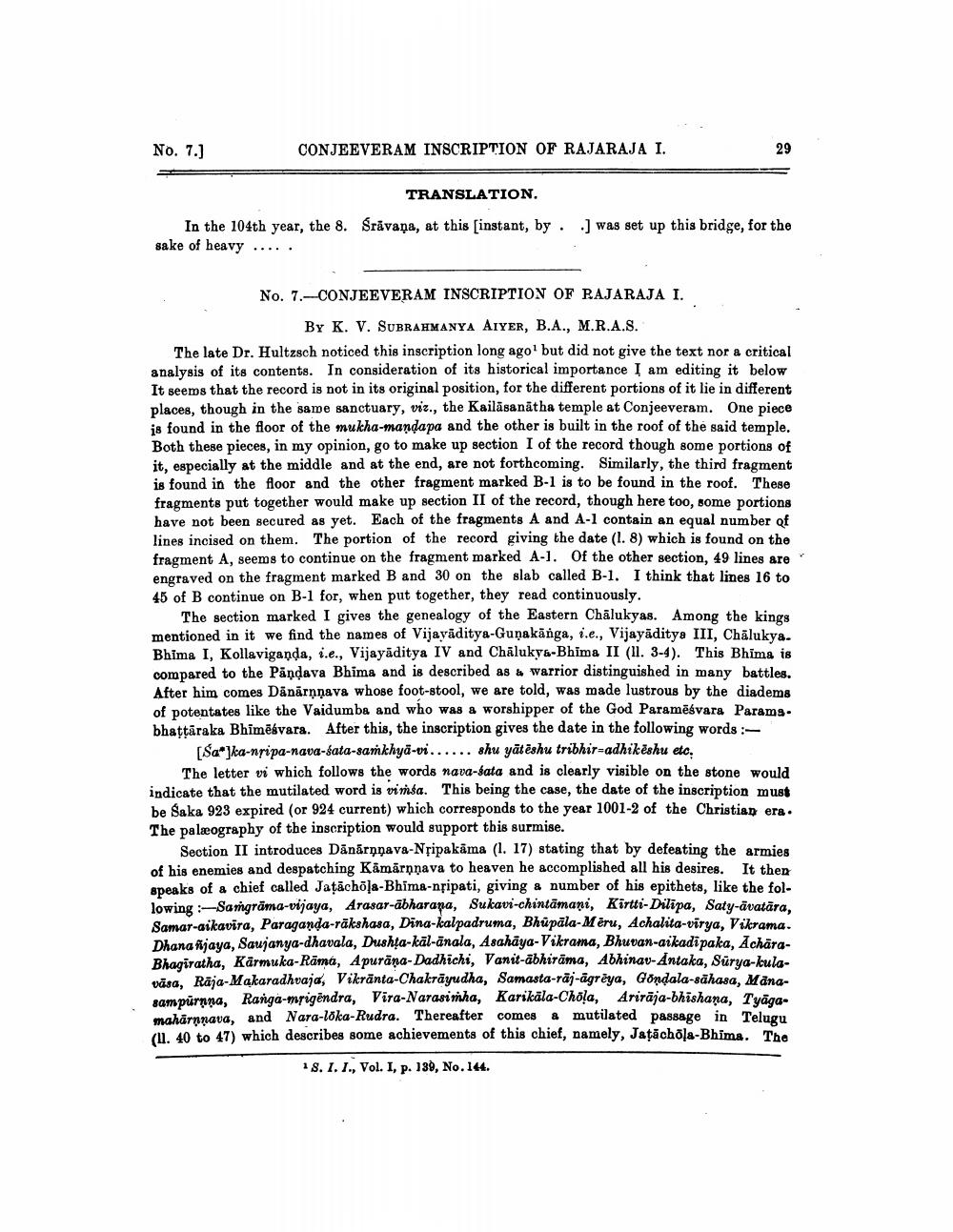________________
No. 7.]
CONJEEVERAM INSCRIPTION OF RAJARAJA I.
29
TRANSLATION.
In the 104th year, the 8. Śrāvana, at this [instant, by . .] was set up this bridge, for the sake of heavy
No. 7.-CONJEEVERAM INSCRIPTION OF RAJARAJA I.
BY K. V. SUBRAHMANYA AIYER, B.A., M.R.A.S.
The late Dr. Hultzsch noticed this inscription long ago1 but did not give the text nor a critical analysis of its contents. In consideration of its historical importance I am editing it below It seems that the record is not in its original position, for the different portions of it lie in different places, though in the same sanctuary, viz., the Kailasanatha temple at Conjeeveram. One piece is found in the floor of the mukha-manḍapa and the other is built in the roof of the said temple. Both these pieces, in my opinion, go to make up section I of the record though some portions of it, especially at the middle and at the end, are not forthcoming. Similarly, the third fragment is found in the floor and the other fragment marked B-1 is to be found in the roof. These fragments put together would make up section II of the record, though here too, some portions have not been secured as yet. Each of the fragments A and A-1 contain an equal number of lines incised on them. The portion of the record giving the date (1. 8) which is found on the fragment A, seems to continue on the fragment marked A-1. Of the other section, 49 lines are engraved on the fragment marked B and 30 on the slab called B-1. I think that lines 16 to 45 of B continue on B-1 for, when put together, they read continuously.
The section marked I gives the genealogy of the Eastern Chalukyas. Among the kings mentioned in it we find the names of Vijayaditya-Gunakanga, i.e., Vijayaditya III, Chalukya. Bhima I, Kollaviganda, i.e., Vijayaditya IV and Chalukya-Bhima II (11. 3-4). This Bhima is compared to the Pandava Bhima and is described as a warrior distinguished in many battles. After him comes Dānārņṇava whose foot-stool, we are told, was made lustrous by the diadems of potentates like the Vaidumba and who was a worshipper of the God Parameśvara Params. bhaṭṭāraka Bhīmē vara. After this, the inscription gives the date in the following words :
[Sa ka-nripa-nava-sata-saṁkhyā-vi...... shu yātēshu tribhir-adhikeshu etc.
The letter vi which follows the words nava-sata and is clearly visible on the stone would indicate that the mutilated word is vimsa. This being the case, the date of the inscription must be Saka 923 expired (or 924 current) which corresponds to the year 1001-2 of the Christian era. The palæography of the inscription would support this surmise.
Section II introduces Dānārņņava-Nṛipakāma (1. 17) stating that by defeating the armies of his enemies and despatching Kämärņņava to heaven he accomplished all his desires. It then speaks of a chief called Jaṭachōla-Bhima-nripati, giving a number of his epithets, like the following:-Samgrama-vijaya, Arasar-abharana, Sukavi-chintamani, Kirtti-Dilipa, Saty-avatāra, Samar-aikavira, Paraganda-rakshasa, Dina-kalpadruma, Bhupala-Meru, Achalita-virya, Vikrama. Dhana jaya, Saujanya-dhavala, Dushṭa-kal-anala, Asahāya-Vikrama, Bhuvan-aikadi paka, AcharaBhagiratha, Kärmuka-Rama, Apurana-Dadhichi, Vanit-abhirama, Abhinav-Antaka, Surya-kulavasa, Raja-Makaradhvaja, Vikranta-Chakrayudha, Samasta-rāj-āgrēya, Gönḍala-sähasa, Mānasampurnna, Ranga-mrigendra, Vira-Narasimha, Karikala-Chōla, Ariraja-bhishana, Tyagamahārņṇava, and Nara-lõka-Rudra. Thereafter comes a mutilated passage in Telugu (11. 40 to 47) which describes some achievements of this chief, namely, Jaṭāchōla-Bhima. The
18. I. I., Vol. I, p. 139, No. 144.




